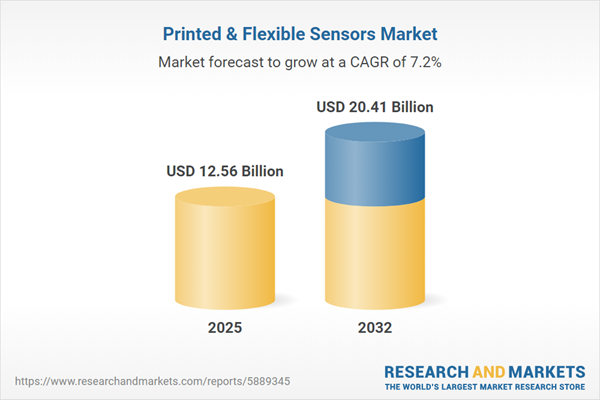Speak directly to the analyst to clarify any post sales queries you may have.
The printed and flexible sensors market is empowering organizations to transform data capture and operational responsiveness across multiple sectors. As adoption intensifies, enterprises are prioritizing sensor solutions that combine scalability, regulatory alignment, and speed-to-market to stay ahead in an increasingly dynamic environment.
Market Snapshot: Printed and Flexible Sensors Market
The printed and flexible sensors market is on a strong growth trajectory, reaching a size of USD 11.74 billion in 2024 and projected to rise to USD 12.56 billion in 2025, indicating a compound annual growth rate (CAGR) of 7.15%. This expansion is propelled by heightened integration of innovative sensor technologies, evolving global supply strategies, and new regulatory imperatives. Investments in digital infrastructure, collaborative innovation, and enhanced product portfolios are enabling organizations to address evolving compliance needs and competitive pressures. As new use cases accelerate adoption, stakeholders are capitalizing on both emerging demand and shifts in sector priorities.
Scope & Segmentation: Core Areas Shaping Market Evolution
- Sensor Types: Biosensors, gas, humidity, pressure, and temperature sensors are essential for real-time diagnostics, maintaining safety standards, environmental monitoring, and advancing industrial automation.
- Technology Platforms: Aerosol jet, flexographic, gravure, inkjet, and screen-printing support scalable and customizable sensor production, suited to healthcare, industrial, and next-generation consumer technology applications.
- Material Types: Paper, PET, engineered plastics, and specialty textiles allow for integration into wearables, medical diagnostics, and systems that operate under variable or demanding conditions.
- End Use Industries: Aerospace, defense, automotive, food and beverage, consumer electronics, and healthcare sectors are leveraging these sensors to improve operational accuracy, product quality, and ensure compliance.
- Application Domains: Environmental safety monitoring, health wearables, food chain tracking, and infrastructure integrity evaluations facilitate advanced analytics and quicker management decisions.
- Regional Breakdown: The Americas, Europe, Asia-Pacific, and Middle East & Africa each address market opportunities through region-specific investment strategies and regulatory frameworks, with the US, China, Germany, Japan, and India spearheading innovation.
- Company Analysis: Major industry players—including DuPont de Nemours, Avery Dennison, Nissha Printing, TE Connectivity, Fujifilm Holdings, 3M, DIC Corporation, TDK, Nitto Denko, and Honeywell International—continue to shape market direction through technological advancement and strategic market positioning.
Key Takeaways for Senior Decision-Makers
- Flexible printed sensors drive rapid product development and enable diverse functionality, allowing for seamless deployment in automation, healthcare, and advanced electronics projects.
- Collaboration among suppliers and manufacturers enhances compliance strategies and fortifies supply chains against regulatory and logistical shifts.
- Advances in digital and roll-to-roll printing technologies support cost-efficient, high-throughput production, ensuring stable supply performance for global operations.
- The integration of sensor systems with artificial intelligence and edge computing positions organizations to make proactive, informed decisions driven by real-time analytics and predictive capabilities.
- Strategic focus is intensifying around regulatory agility and innovation adaptability, especially in the Asia-Pacific and European regions, as organizations reevaluate sourcing and growth priorities.
Tariff Impact: Navigating New US Trade Dynamics
Changes in US tariff structures are prompting organizations in the printed and flexible sensors market to reassess sourcing strategies and adapt supply chain configurations. In response, many firms are expanding supplier networks and exploring alternative assembly locations to maintain reliability and efficiency within a variable global trade environment.
Methodology & Data Sources
This market analysis combines direct interviews with senior industry executives, a thorough review of public financial records, and targeted assessments of patent trends. A rigorous process of expert validation and multi-layered data verification assures the accuracy and relevance of insights for decision-makers.
Why This Report Matters
- Segmented market intelligence and trend analysis empower leaders to uncover new business opportunities and optimize strategy.
- Comprehensive evaluation illuminates regulatory and supply chain dynamics, supporting timely, data-driven operational adjustments across markets.
- Innovation-focused recommendations help companies boost adaptability and sustain resilience as the printed and flexible sensors market landscape evolves.
Conclusion
Printed and flexible sensors equip enterprises with adaptable, reliable tools to meet changing operational and compliance needs. Effective integration supports ongoing agility amid sector and global market shifts.
Additional Product Information:
- Purchase of this report includes 1 year online access with quarterly updates.
- This report can be updated on request. Please contact our Customer Experience team using the Ask a Question widget on our website.
Table of Contents
3. Executive Summary
4. Market Overview
7. Cumulative Impact of Artificial Intelligence 2025
Companies Mentioned
The companies profiled in this Printed & Flexible Sensors market report include:- DuPont de Nemours, Inc.
- Avery Dennison Corporation
- Nissha Printing Co., Ltd.
- TE Connectivity Ltd.
- Fujifilm Holdings Corporation
- 3M Company
- DIC Corporation
- TDK Corporation
- Nitto Denko Corporation
- Honeywell International Inc.
Table Information
| Report Attribute | Details |
|---|---|
| No. of Pages | 189 |
| Published | November 2025 |
| Forecast Period | 2025 - 2032 |
| Estimated Market Value ( USD | $ 12.56 Billion |
| Forecasted Market Value ( USD | $ 20.41 Billion |
| Compound Annual Growth Rate | 7.1% |
| Regions Covered | Global |
| No. of Companies Mentioned | 11 |









